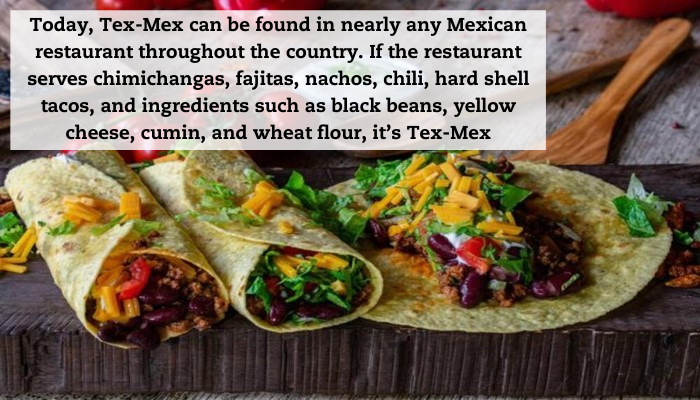If you’ve spent some time in Texas, you know that Texans are wild about Tex-Mex—and for good reason! After all, who doesn’t love chili and nachos? The delectable flavors of queso, enchiladas, and chili con queso are enough to make anyone’s mouth water. A staple of Texan cuisine since the late 1800s, Tex-Mex is very popular throughout the country and has been commercialized by companies such as Chili’s, Chipotle, Moe’s, Qdoba, and other chains.
Today, Tex-Mex can be found in nearly any Mexican restaurant throughout the country. If the restaurant serves chimichangas, fajitas, nachos, chili, hard shell tacos, and ingredients such as black beans, yellow cheese, cumin, and wheat flour, it’s Tex-Mex.
But when and where, exactly, was Tex-Mex cuisine first invented? Read on to learn the delicious origins of Tex-Mex.
What Are the Origins of Tex-Mex Cuisine?
When we consider the popularity of Tex-Mex, it may be hard to believe that this style of cuisine wasn’t nearly as respected or as popular as it is today. Tex-Mex originated in the Rio Grande Valley, which is a region encompassing the southernmost part of Texas and northern part of Mexico. In the early 16th century, Spain invaded Mexico and set up colonies throughout the country. In the centuries that followed, Spain introduced Mexico to their customs, economic systems, religion, and—of course—their food. By 1821, which was when Mexico established independence from Spain, Mexico was heavily influenced by Spanish culture and cuisine and began to incorporate the recipes and ingredients that had been introduced to them from Spain.
Texas was considered part of Mexico until 1836, when it declared independence from Mexico and became a part of the United States. After declaring independence, Tejanos (Texans of Mexican descent) began introducing Mexican recipes to America. Over time, Mexican food served in Texas began to incorporate new flavors into their dishes as Americans migrated to Texas, which established several important distinctions between traditional Mexican food and what we now know as Tex-Mex.
Barbacoa, nachos, tortillas, and burritos rose in popularity and were introduced to restaurants as Mexican food, while spices that had never been used in Mexican food before—such as cumin—became essential ingredients in Tex-Mex food.
What Was San Antonio’s Role in Establishing Tex-Mex Within the United States?
As Mexican food rose in popularity in Texas, San Antonio helped establish Tex-Mex as a staple cuisine in the United States. San Antonio is home to one of the most popular and beloved Tex-Mex dishes: chili. In the 1870s-1880s, a group of women who called themselves “chili queens” served chili con carne with chili verde, enchiladas, and tamales in plazas throughout San Antonio. Word spread quickly, and soon tourists were lining up to try the delectable chili. This widespread popularity helped Mexican food enter mainstream American cuisine.
Today, San Antonio is regarded as a leader in Tex-Mex cuisine, home to many of the best Tex-Mex chefs in the country. Among them include celebrated chef Johnny Hernandez who is an authority on Mexican cuisine and helped establish San Antonio as a culinary destination.
Is Tex-Mex the Same as Mexican Food?
While Tex-Mex and Mexican food share some similarities, there are several important distinctions as well. If the dish has black beans instead of pinto beans, that indicates that it’s Tex-Mex. Mexico only has white cheese, so if yellow cheese is used, it’s Tex-Mex. Chimichangas, fajitas, nachos, chili, hard shell tacos, black beans, yellow cheese, and wheat flour are all Tex-Mex dishes and ingredients and typically aren’t found south of the Mexican border. The spices used to flavor the food create another important distinction between the two. Mexican food tends to be spicier and weaves in chili peppers, epazote, cacao, oregano, and cilantro, whereas Tex-Mex dishes tend to be a bit milder and feature cumin as a primary ingredient.
Where Does the Phrase “Tex-Mex” Come From? (This One May Surprise You!)
Many assume that Tex-Mex is simply an abbreviated combination of the words Texas and Mexico. However, the phrase wasn’t used to describe food at all when it first came about. Tex-Mex was used as an abbreviation for the Texas Mexican Railway that ran in Southern Texas in the 1870s. Over time, the term caught on and was used to describe Tejanos, who are Texans of Mexican descent.
In 1963, an article in the New York Times referred to Mexican food in Texas as “Tex-Mex,” which was the first time the phrase was used to describe the cuisine. It wasn’t until 1972 when an author named Diana Kennedy published a Mexican cookbook that the term Tex-Mex became fully popularized. Kennedy spent more than fifty years traveling through Mexico and wrote several books about Mexican cuisine. In her book that officially popularized Tex-Mex, titled The Cuisine of Mexico, she referred to Mexican food in Texas as “Tex-Mex” and drew the distinction between authentic Mexican cuisine and Mexican food in Texas. Her book helped establish Tex-Mex cuisine within American culture and give it legitimacy, popularity, and a newfound level of respect.
Living in San Antonio
If you love Tex-Mex, there is no better place to live than San Antonio. Located only an hour and a half southwest of Austin and two and a half hours from the border of Mexico, San Antonio is a vibrant city filled with rich culture, historical landmarks, and the best Tex-Mex the country has to offer. With historical sites such as the Alamo, Tower of the Americas, Missions National Historical Park, and more, San Antonio is an excellent place to live.
Discover exceptional luxury condo living at Sonterra Blue, located in the Stone Oak neighborhood in San Antonio. The build offers one-, two- and three-bedroom apartments ranging from 657 to 1,506 square feet, select residences offer private backyards, patios, or balconies. Community amenities include a beautiful outdoor pool with grills, a picnic area, and a hot tub as well as an elegant clubhouse, coworking area, and 24-hour gym.
Sonterra Blue is located near San Antonio’s famous Riverwalk, offering fantastic dining (many of which are Tex-Mex options!), vibrant nightlife, and tons of family-friendly entertainment for kids such as the San Antonio Zoo, Six Flags Fiesta Texas, Schlitterbahn water park, the Witte Museum, and the San Antonio Botanical Garden. Visit Draper and Kramer today to learn more about Sonterra Blue and to schedule a tour.

As Mexican food rose in popularity in Texas, San Antonio helped establish Tex-Mex as a staple cuisine in the United States. Today, San Antonio is regarded as a leader in Tex-Mex cuisine, home to many of the best Tex-Mex chefs in the country.